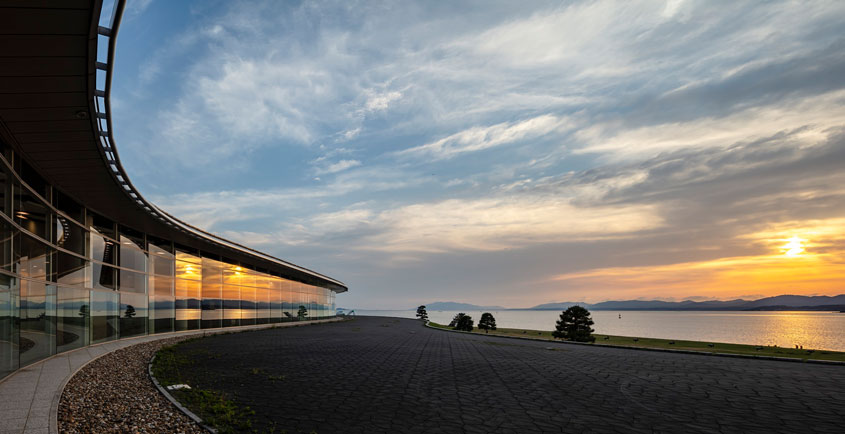SHIMANE ART MUSEUM

SHIMANE ART MUSEUM lobby
SHIMANE ART MUSEUM themed around harmony with water, blending into the beautiful landscape of Lake Shinji. The permanent collection includes the "Waterside Exhibition Room" and approximately 40 pieces from the world-class Hokusai Collection in the "Hokusai Exhibition Room." Other exhibits feature domestic and international photography, sculptures made from wood, and artwork from Shimane Prefecture. The lobby, offering a stunning view of the sunset over Lake Shinji, is open to the public for free. From March to September, the closing time is set to 30 minutes after sunset, allowing visitors to enjoy the exhibits leisurely after witnessing the sunset.
The museum holds a collection of approximately 3,000 pieces of ukiyo-e work and documents, and part of it, which we are particularly proud in terms of volume and quality, is the rich collection of the ukiyo-e master who stands as a symbol of the Edo period (1603-1867): Katsushika Hokusai (1760-1849). The core of this collection is the Nagata Collection, donated in 2017 by the Tsuwano-born Hokusai researcher Nagata Seiji (1951-2018). This collection covers each field of Hokusai’s work, including nishiki-e color prints, surimono prints, wood block print books, and hand-painted pieces, and also various themes, from major to minor, including several of the crowning achievements of his life, as well as rare or absolutely unique prints and documents. It also contains work by Hokusai’s students, including Teisai Hokuba, and Totoya Hokkei, altogether reaching 2,398 works. Including groups of work from the former collection of Shinjo Jiro from Matsue (amongst them Thirty-six Views of Mount Fuji), and other pieces we have purchased, the overall number of artworks related to Hokusai owned by the museum is 2,500, of which 1,600 are by Hokusai himself. It is the collection of a single museum, yet it allows us to read the life of Hokusai through many epochs, which is one of its defining characteristics.
At any time,you can view about 40 works by Hokusai Exhition Room.






All in SHIMANE ART MUSEUM collection

SHIMANE ART MUSEUM Waterside Exhibition Room

SHIMANE ART MUSEUM HOKUSAI collection Exhibition Room


SHIMANE ART MUSEUM/EXTERIOR2
Main works
This museum, designed to harmonize with the view of Shinjiko Lake, has allocated “Paintings with the Theme of Water” as a significant area in its collection. Essential to life, water has always been involved in human activity and has featured in innumerable painting works.
In Japan, too, water has been expressed in many ways. From pre-modern era painting that evolved under the influence of Chinese painting, through ukiyo-e, which had a major influence on Western art, and to both Japanese- and Western-style painting in the modern period, as the nation increased its communication and exchanges with Western countries, the way in which water was expressed reflected the period, forms and methods of each time.
Additionally, in Western countries, nature itself came into focus as a theme in painting, and landscape painting that depicted the reality of nature was considered an important genre. Corot, Courbet, and the Impressionists and Fauvists, who all had a major influence on subsequent art movements, often painted landscapes featuring the motif of water.
We hope that you will enjoy the colorful expressions of water by artists of Japan and Western countries.


Matsudaira Naritake, the 9th lord of Matsue, was a leading figure in the introduction of photography in the San-in region, which took place in Matsue Domain in the Bunkyu period (1861-1864). Since then it has produced a significant photographer in each period: Kamei Koreaki in the Meiji era (1868-1912); Shiotani Teiko in the Pictorialism period between Taisho and early Showa (the 1920s and 30s ); Ueda Shoji in the period of modernism, Narahara Ikko, leading Japanese post-war photography; and Moriyama Daido, known as one of the top artists in the world today. While celebrating these epochs, the photography section of the Shimane Art Museum has built a collection that traces the history of photography “From Daguerreotype to the Present .” International works are collected with the relationship between photography and painting in focus, and include work mainly from France and the US, but also from the UK, Germany, and Austria. The museum’s collection has roughly 4,000 pieces that illustrate the history of domestic and international photography, and it holds four exhibitions a year on different themes, featuring about 120 pieces each time.


- RODIN, Auguste,Monument to Victor Hugo,1897,SHIMANE ART MUSEUM collection
- TAKAMURA Kotaro,Hand,1918,SHIMANE ART MUSEUM collection
- KISHIDA Ryusei,Self-Portrait,1914,SHIMANE ART MUSEUM collection
- ISHIBASHI Kazunori,Lady Reading Poetry,1906,SHIMANE ART MUSEUM collection
- TSUCHIYA Unzen,Water jar after a Seto piece, Fujina ware,Late Edo period,SHIMANE ART MUSEUM collection
- NURUDEAN Mitsuhide,Tea container with chrysanthemum design,Late Edo period,SHIMANE ART MUSEUM collection
- ITO Jakuchu,Rooster, Hen and Chickens,c.1789,SHIMANE ART MUSEUM collection
- OCHIAI Rofu,Mermaids,1934,SHIMANE ART MUSEUM collection



